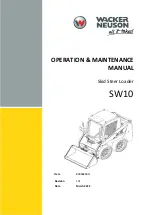
9. Clean up any spilled fluid.
10. Start the engine and let it run for about two
minutes to purge air from the system.
11. Stop the engine and check for leaks.
12. Check the fluid level in the hydraulic tank (refer
to Checking the Hydraulic Fluid, in Operation)
and add fluid to raise the level to the mark on
the dipstick. Do not over fill the tank.
13. Install the front access cover.
14. Remove and store the cylinder locks and lower
the loader arms.
Changing the Hydraulic
Fluid
Change the hydraulic fluid yearly.
1. Position traction unit on a level surface.
2. Raise the loader arms and install the cylinder
locks.
3. Stop the engine and remove the key.
4. Remove the front access cover.
Important:
Do not substitute automotive
transmission fluid or severe hydraulic
system damage may result.
5. Place a large drain pan under the traction unit
that can hold at least 17 gal. (67 l).
6. Remove the drain plug from the bottom of the
hydraulic tank and allow the fluid to completely
drain out.
7. Install the drain plug.
8. Fill the hydraulic tank with 10W-30 or 15W-40
detergent, diesel engine oil (API service CH-4
or higher); refer to Checking the Hydraulic
Fluid, in Operation.
Note:
Dispose of used oil at a certified
recycling center.
9. Install the front access cover.
10. Remove and store the cylinder locks and lower
the loader arms.
Checking the Hydraulic
Lines
After every 25 operating hours, check the hydraulic
lines and hoses for leaks, loose fittings, kinked
lines, loose mounting supports, wear, weather,
and chemical deterioration. Replace all moving
hydraulic hoses every 1500 hours or 2 years, which
ever comes first. Make necessary repairs before
operating.
Hydraulic fluid escaping under pressure
can penetrate skin and cause injury. Fluid
injected into the skin must be surgically
removed within a few hours by a doctor
familiar with this form of injury or gangrene
may result.
•
Keep your body and hands away from
pin hole leaks or nozzles that eject high
pressure hydraulic fluid.
•
Use cardboard or paper to find hydraulic
leaks, never use your hands.
Cleaning
Removing Debris from the
Traction Unit
Important:
Operating the engine with a
blocked radiator, may result in engine damage
from overheating.
1. Park the traction unit on a level surface, raise
the loader arms, and install the cylinder locks.
2. Stop the engine and remove the key.
3. Remove the front access cover.
4. Clean any debris from the grill.
5. Open the rear access cover.
6. Wipe away debris from the air cleaner.
7. Clean any debris build-up on the engine with a
brush or blower before each use.
Important:
It is preferable to blow
dirt out, rather than washing it out. If
water is used, keep it away from electrical
items and hydraulic valves. Do not use
a high-pressure washer. High-pressure
washing can damage the electrical system
and hydraulic valves or deplete grease.
8. Replace and secure the front and rear access
covers.
9. Remove and store the cylinder locks and lower
the loader arms.
33
Содержание 22303 Dingo 320-D
Страница 7: ...Slope Chart 7...
































